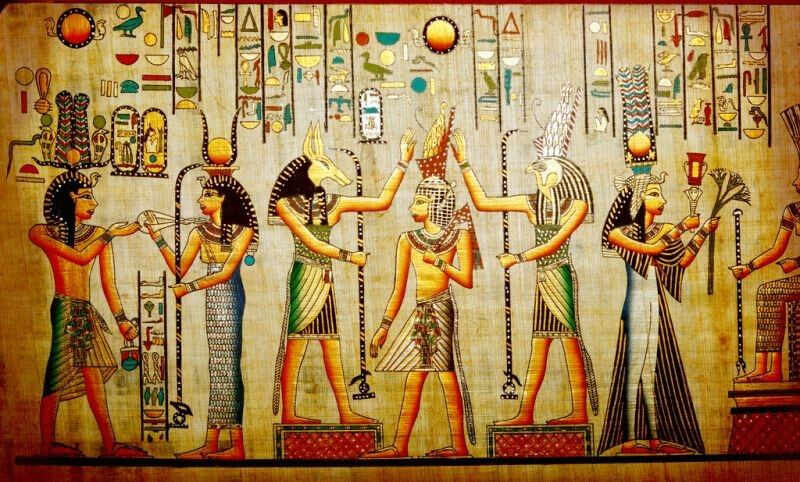Ancient Egypt
The funeral rites of the Egyptians have allowed us to learn a lot about their life.
The inscriptions made on papyrus and on tombstones, on sarcophagi and pyramids, allow us to get acquainted with the smallest details of their daily life.
The mummies that have survived to this day give us precious information about what kind of food the Egyptians ate, how they got sick, what hairstyles they preferred, what clothes they wore.
The ancient Egyptians divided the world into the earthly (the world of the living) and the afterlife (the world of the dead), the sun equally shone on the living and the dead. In the kingdom of Osiris, the soul of the deceased had to justify himself before him in order to gain eternal and blessed life.
In life, the earthly Egyptian worshiped the living incarnation of the sun god – the pharaoh.
It was believed that in order to travel to the afterlife, it is especially important to keep the body of the deceased intact: after all, the soul (the Egyptians called it Ka) should be in an intact, whole shell during this journey.
Naturally, there were many different ways to preserve the bodies of the dead. At first, the bodies were buried in very shallow graves in hot sand, where they quickly dried out and were thus preserved.
Later, rich Egyptians began to be buried in sarcophagi, but at the same time, the bodies of the dead were previously embalmed in order to preserve them and protect them from decomposition.
Skills of professional embalmers

The skills of professional embalmers were so high that the bodies with which they worked remained in excellent condition even after several thousand years.
Unfortunately, no instructions or “manuals” for the proper storage of the bodies have been preserved, but the bodies themselves have been preserved, which can be examined.
Through trial and error, scientists found that after death, organs were removed from the body and stored in special vessels containing a concentrated solution of salt, soda and water.
After 2 months, the organs were returned to the body and the dead were sent on their way.
Which organs were stored in vessels: a vessel with a human head – the liver, a vessel with a baboon’s head – the lungs, a vessel with a hawk’s head – the intestines, a vessel with a jackal’s head – the stomach.
From about 3400 B.C. with the help of the high art of mummification, the bodies of the dead were prepared for a journey to the afterlife and for their preservation in eternity.
For 70 days the remains were in solution, then the embalming continued and included a lot of technological stages.
So, the mummies of the pharaohs could be preserved in their original state even after millennia.
The underworld itself is called Duat, it is located under the sources of the Nile River. Upon entering the afterlife, a terrible test awaited the dead: an assessment of the deeds committed during life.

They took the heart from the deceased, as a symbol of his honesty, and put it on one scale, on the other side lay an ostrich feather.
After the test, the participants were divided into three groups.
Those whose evil deeds weighed more than their good deeds were given to the Devourer to eat.
Those whose virtues outweighed their shortcomings were considered gods and sent to the Fields of Ialu. And those who had equally good and evil deeds were forced to serve Osiris.
The sun god Ra created the fields of Ialu as a place where he can rest from his duties and spend time in peace. Osiris was appointed to keep order in the fields.
In the fields, souls acquire eternal life and bliss, they do the same things as during life, but in more comfortable conditions.
Hard work and household chores here are performed by idols instead of people, who were supposed to go along with the soul to judgment.
Osiris in Egyptian mythology is presented as a versatile person. He was at the same time the god of rebirth, the king of the underworld and the judge for the souls of the dead.
It was believed that, like the entire plant world, Osiris dies every year and is reborn to a new life, but the fertilizing life force in him is preserved even in the dead.
Usually depicted as a green-skinned mummy wrapped in white cloth, with free hands holding the heket and nekhehu (scepter and flail) symbols of royal power. The crown he wears is made from papyrus stalks.
God was never depicted without any plant: sometimes it was a lotus that grows near his throne, and sometimes his robes wrap around vines.
Those who did many bad deeds were “sent” to Amat – the Devourer of Souls.
Amat is usually depicted as a monster that combines the features of a crocodile and a lion.
Amat was almost always present at the trial. When Osiris weighed the souls on the scales, and they weighed more than an ostrich feather, Amat immediately ate the soul.